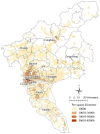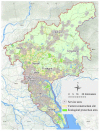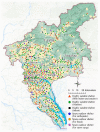Urban Resources Selection and Allocation for Emergency Shelters: In a Multi-Hazard Environment
- PMID: 29903997
- PMCID: PMC6025408
- DOI: 10.3390/ijerph15061261
Urban Resources Selection and Allocation for Emergency Shelters: In a Multi-Hazard Environment
Abstract
This study explores how emergency shelters can adapt to a multi-hazard environment by geographic information system (GIS) and takes Guangzhou as a case for analysis. The physical suitability of the overall urban resources was first assessed by aiming to select the suitable resources and safe locations for emergency shelters in the context of multiple disasters. Afterward, by analyzing the scale and spatial distribution of affected areas and populations under different types of disaster scenarios, the demand for different kinds of shelters were predicted. Lastly, taking into account the coverage of the affected people, shelters were allocated according to different conditions in the districts. This work will hopefully provide a reference for the construction of emergency shelters and help form emergency operations in order to mitigate the impact of hazards. The issues identified in the study need to be further studied in medium or small-scale cities.
Keywords: emergency shelter; multi-hazard environment; urban resource.
Conflict of interest statement
The authors declare no conflict of interest.
Figures








Similar articles
-
Typhoon track change-based emergency shelter location-allocation model: a case study of Wenchang in Hainan province, China.Inj Prev. 2020 Jun;26(3):196-203. doi: 10.1136/injuryprev-2018-043081. Epub 2019 Apr 11. Inj Prev. 2020. PMID: 30975763 Free PMC article.
-
Spatial Layout Planning of Urban Emergency Shelter Based on Sustainable Disaster Reduction.Int J Environ Res Public Health. 2023 Jan 24;20(3):2127. doi: 10.3390/ijerph20032127. Int J Environ Res Public Health. 2023. PMID: 36767495 Free PMC article.
-
Scenario-Based Multi-Objective Optimum Allocation Model for Earthquake Emergency Shelters Using a Modified Particle Swarm Optimization Algorithm: A Case Study in Chaoyang District, Beijing, China.PLoS One. 2015 Dec 7;10(12):e0144455. doi: 10.1371/journal.pone.0144455. eCollection 2015. PLoS One. 2015. PMID: 26642322 Free PMC article.
-
Instructions for planning emergency shelters and open spaces in China: Lessons from global experiences and expertise.Int J Disaster Risk Reduct. 2020 Dec;51:101813. doi: 10.1016/j.ijdrr.2020.101813. Epub 2020 Aug 23. Int J Disaster Risk Reduct. 2020. PMID: 32864326 Free PMC article. Review.
-
K-Shortest-Path-Based Evacuation Routing with Police Resource Allocation in City Transportation Networks.PLoS One. 2015 Jul 30;10(7):e0131962. doi: 10.1371/journal.pone.0131962. eCollection 2015. PLoS One. 2015. PMID: 26226109 Free PMC article. Review.
Cited by
-
Wind disasters adaptation in cities in a changing climate: A systematic review.PLoS One. 2021 Mar 17;16(3):e0248503. doi: 10.1371/journal.pone.0248503. eCollection 2021. PLoS One. 2021. PMID: 33730069 Free PMC article.
-
How Can Cities Adapt to a Multi-Disaster Environment? Empirical Research in Guangzhou (China).Int J Environ Res Public Health. 2018 Nov 3;15(11):2453. doi: 10.3390/ijerph15112453. Int J Environ Res Public Health. 2018. PMID: 30400330 Free PMC article.
-
Emergency Relief Chain for Natural Disaster Response Based on Government-Enterprise Coordination.Int J Environ Res Public Health. 2022 Sep 7;19(18):11255. doi: 10.3390/ijerph191811255. Int J Environ Res Public Health. 2022. PMID: 36141522 Free PMC article.
-
How Can Cities Respond to Flood Disaster Risks under Multi-Scenario Simulation? A Case Study of Xiamen, China.Int J Environ Res Public Health. 2019 Feb 20;16(4):618. doi: 10.3390/ijerph16040618. Int J Environ Res Public Health. 2019. PMID: 30791558 Free PMC article.
-
Multiobjective Emergency Resource Allocation under the Natural Disaster Chain with Path Planning.Int J Environ Res Public Health. 2022 Jun 27;19(13):7876. doi: 10.3390/ijerph19137876. Int J Environ Res Public Health. 2022. PMID: 35805533 Free PMC article.
References
Publication types
MeSH terms
LinkOut - more resources
Full Text Sources
Other Literature Sources
Medical

